

Tuesday, October 7, 2025 | Santa Monica High School | Volume CXII - Issue I



Tuesday, October 7, 2025 | Santa Monica High School | Volume CXII - Issue I
Kira Willinger Staff Writer
On Aug. 26, the fifteen-year-old Nordstrom location at the Santa Monica Place closed down. Part of an ongoing trend of closures around the Downtown Santa Monica area in recent years, the promenade continues to faces high vacancy rates, with rates at 22 percent in July 2025. The emptiness on the promenade has been caused by multiple components, including the high rent and lingering effects of COVID-19. Due to this, the promenade has lost many visitors. As a result, the promenade has been passing policies in an attempt to revitalize the area, part of the

city’s larger goal to guide the promenade back to its past state.
This summer, the promenade launched its new “Entertainment Zone” running from
Wilshire Boulevard to Broadway. The new “zone” allows citizens to drink alcoholic drinks openly outside from 11 a.m. to 10 p.m, with the implementation being approved by the City Council in “effort to support economic development and bring new experiences to the iconic Third Street Promenade shopping district.” However, some in Downtown Santa Monica have expressed their concerns about the maintenance of the promenade increasing due to a rise in littering and the need for more security.
Shahar Naiberg (’28) amplified questions about safety following the policy.
“I think it could potentially turn dangerous because people consume alcohol and then they lose all rational thought. There’s kids on the promenade,” Naiberg said. “No one wants to see someone intoxicated in a public place. It makes me uncomfortable and I think it makes other people uncomfortable.”
Additionally, the promenade will be hosting the opening of a long-awaited Raising Cane’s, the popular chicken-tender fast-food chain. Santa Monica had a ban on fast-food chains with more than 150 locations in an effort to promote local smaller businesses; however, that ban was suspended in 2023 as an interim measure, with it being upheld in Aug. 2025. The Rasing Canes will be opening where the former asian grill restaurant, Bibibop, used to be and will also be expanding into the past Yogurtland location.
New CTE pathway classes launched
Launched this fall at Samo are the new Career Technical Education (CTE) pathway classes; the Health and Wellness Academy and the Law and Public Policy Academy. These new classes are an addition to already existing CTE programs, such as the Arts, Media, and Entertainment pathway and the Engineering pathway.
CTE classes are programs specifically designed towards students interested in a certain subject, like graphic design, that they are planning to pursue as a career. The main goal of these courses is to


The Samohi is a designated public forum for student expression without prior review by school officials in which students make all final content decisions.
The by-lined opinions expressed in the Editorial/Opinion and Entertainment sections and columns are those of the writer and do not necessarily reflect the opinion of The Samohi. Any opinions or views expressed in advertisements do not necessarily reflect those of The Samohi. Not all submissions will be printed and may be edited to conform to The Samohi policy or to meet space restrictions.
As of Sept. 15, Samo renewed its attendance policy and launched new measures in an attempt to increase student attendance. All carryover absences from previous years have been reset, with every student starting this semester from zero. Following this update, the number of unrestored period absences seniors must be below to participate in graduation dropped from 120 to 60. To be able to engage in Samo sports and performances, students are required to keep their unrestored period absences below 18. This also applies to eligibility for an off-campus lunch pass. If a student reaches over this limit, they have one week to make up atten dance and documentation must be submitted to the designated House Office for confirma tion.
The “Perfect Attendance Raf fle” also comes as a new addition in incentivizing students to attend class. Every student who has been “consistently present and on time” throughout the month will have their name entered into a raffle, and the winners will receive a prize. While administrators are still in the process of figuring out the exact prizes, it is expected that these prizes will include gift cards and swag/gear from the Vikings’ Inn and/
thesamohinews@gmail.com
learn applicable lessons through handson experiences, like fixing up a wound. The focus is not on textbook learning but rather on developing valuable skills that will equip students for their future.
Both Academies are a one-year pathway program, with students taking three back-to-back periods. The class is available for 11th and 12th graders who have more flexibility in their schedules, with the juniors and seniors being separated.
Katrina Reyes, Samohi biology teacher and one of the three teachers for the Health and Wellness Academy, shared her thoughts on the program.
“I think it is a way to get students to be more connected to their teachers, more connected to their classmates. So that’s one of our goals,” Reyes said. Moreover, Reyes expressed what type of students may like to take the class.
“There are a lot of very academically rigorous classes, but I think we’re really just trying to tap into students who are not necessarily the most engaged in school. They’re not necessarily the ones who are signing up for five APs, but they’re looking for ways to connect to school better,” Reyes said.
thesamohinews@gmail.com
Editor-in-Chief
Liam Sauer
Managing Editor
Claire Harrison
Business Manager
Addie Burns
News Editors
Eugene Naruse
Louis Rotgin
Opinion Editor Leo Lucente
or Margaret’s Place, and a fast pass allowing students to cut to the front of the lunch line. Details of the fast pass are still under consideration.
Siena Shickler (’28) stated her opinions on the skip the lunch line pass.
“Every single day, the lunch line is just extremely long and you might not even have time to finish it. [The skip the line pass] is even more of an incentive to come to school, and I think that’s a really good prize for perfect attendance,” Shickler said.

Tristan Komlos, S House principal, explained why the school started the perfect attendance raffle.
“We have the system that has obligations in place to assign consequences for student behavior. But what we don’t have is a system that rewards kids for doing the things that they’re already doing. They’re coming to school every day. They’re coming to class every day, and that is the majority of our students on our campus,” Komlos said. “If it gets a student hustling a little bit more in between classes so that they’re on time, the teacher in the classroom community benefits, and what it takes is getting entered in a raffle, then awesome. Let’s do it.”
thesamohinews@gmail.com
Over the summer, Samo overhauled key athletic facilities, including building new basketball courts in the former South Gym location and building new bleachers by the football field.
These new additions are part of a larger campus renovation plan Samo has put into place over the past few years, the Samohi Campus Plan (SCP), which has included the building of the Discovery Building, Gold Gym and Exploration building. The SCP features phases of development, with Samo currently in phase four. Phase four is said to replace the business building with a Student Services Building. This building would be multipurposeful, holding a college and career center, student clubs space, a black box theater and a health and wellness center.
The building of the new bleachers followed the decision to move from rented bleachers to permanent ones, with the bleachers now holding 1900 people.
Colleen Davenport, athletic director, gave further insight into these developments.
“I do think they’re improvements. The outdoor basketball courts are for sure laid out better. So when we either have PE classes out there or athletic teams out there, having them three side by side rather than tandem, you can run practices and supervision much easier,” Davenport said. “The next goal is to get the visiting side to have permanent bleachers, because those are still rentals and
Student Life Editor
Imani Toler
Centerspread Editor
Maxine Kehoe
A&E Editor
Athena Barefoot
Sports Editors
Laurel Cohn
Addy Fiore
Photo Editor
Manny Lopez
Art Editors Florence Fraser-Macduff
Sara Polster
Copy Editors
Koi Lerner
Olivia Stephansen
Digital Editor
Emma Godfrey
Community Liaison
Arata Sakamoto
Faculty Adviser
Elizabeth Stapleton
they are insufficient for what we would like to have at a home stadium,” Davenport said.
Kayla Takeda (’28), junior varsity member of the girls basketball team, compared the new courts to the old ones.

“The courts are really nice. The baskets are new, the lines are not faded like the other older ones,” Takeda said.
Isabella Cardenas (’27) raised a point about the increased amount of space.
“It looks better, it looks more modern, it looks cleaner. It’s a good space,” Cardenas said. “Being in the sun, more space for the boys to play instead of arguing which basketball courts they want.”
thesamohinews@gmail.com
Staff Writers
Ashley Ballantine, Ileana De La Cerda, Lily Edwards, Quinn Forssell, Otem Free, Sophia Freidman, Jack Goldberg, Ramona Häendel, Devyn Hamilton, Jake Phasavath, Yaretzi Presa, Anna Ross, Arturo Singer-Portnoy, Audrey Stephansen, Ashley Tan, Jefferson Tinus, Hope Wang, Kira Willinger
Sports Reporters
Opal Feves, Scarlett Goetz, Leo Mooney, Belle Walker
Singer-Portnoy Staff Writer
On Wednesday, Sept. 10, at 12:23 p.m., Charlie Kirk was shot while debating college students at Utah Valley University. Kirk was pronounced dead by President Donald Trump at 2:40 p.m. on Truth Social.
During an outdoor event for his ‘American Comeback Tour’, Kirk was addressing a crowd of approximately 3,000 people. According to police, a single shot was fired from a rooftop overlooking the event, striking Kirk in the neck shortly after he began his remarks. Samo student Anton Suvak (’27) described what he witnessed in the video circulating shortly after the incident.
“Charlie Kirk picks up his mic, puts down the mic, says something, and [then] you just see him getting shot, and it’s just gushing blood. He drops his mic, faints, and then you can see his security guards just jumping over and piling over him, I guess protecting him. Obviously, the crowd start ed running and screaming,” Suvak said.
Law enforcement officials initially struggled to identify the suspect, combing through tips and video footage in the days after the attack. Two days later, Tyler Robinson, age 22, turned himself in and was taken into custody. He now faces seven charges, including aggravated murder, with prosecutors announcing plans to seek the death penalty.
Court filings have shown that Robinson had texted his partner before the shooting, saying he “was tired of [Kirk’s] hatred.” Investigators pointed to the message as strong evidence that the attack was politically motivated.
Kirk, who was 31-years-old, first rose to prominence after founding Turning Point USA in

questioning how political rhetoric contributes to rising tensions.
“Political differences are not the same thing as spewing hateful rhetoric on a daily basis,” Donegan said.
Reactions swiftly spread across the political spectrum. Supporters hailed Kirk as an advocate for conservative students, with President Trump issuing a statement on the matter.
“ He’s a martyr for truth and freedom and there has never been anyone who was so respected by youth,” Trump said.
The president was quick to claim that it was the responsibility of the “radical left”.
“Radical left political violence has hurt too many innocent people and taken too many lives. Tonight, I ask all Americans to
Singer-Portnoy Staff Writer
On Monday, Sept. 8, the Supreme Court voted to uphold roving patrols for immigration stops in Los Angeles. With immigrants making up roughly 23.3% percent of Santa Monica’s population, the impact of such policies is significant.
While advocacy groups have criticized the policy as discriminatory, the Trump administration frames it as a matter of public safety and national defense.
According to the White House website, “Enforcing our Nation’s immigration laws is critically important to the national security and public safety of the United States.”
Although the city of Santa Monica does not officially deem itself to be a sanctu -
Quinn Forssell Staff Writer


to the American values for which Charlie Kirk lived and died,” Trump said.
Tyler Robinson, the perpetrator, is registered as unaffiliated and both of his parents are registered Republicans.
The shooting has brought into focus the broader climate of political polarization in the United States. Public response has been mixed, with some citing concerns of free speech and others citing controversy surrounding Kirk’s public statements. Samo student and Turning Point USA member Lucky Basseri (‘26) offered comment on the importance of coming together, noting that blaming whole groups increases violence.
strict policies in place for cooperating with border patrol officers. Despite these protections, Immigration and Customs Enforcement (ICE) officers are still visible.
In June, President Donald Trump deployed the National Guard as a response to immigration protests in Los Angeles.
On Sept. 2 a federal judge ruled that this implementation violates the Posse Comitatus Act, which generally prohibits the use of the U.S. military for domestic law enforcement.
legal immigration that threaten national security and public safety. Samo student Joshua Ghermezian (’27) connected his views on immigration directly to how ICE operates.
“It’s as simple as, if you come here and you’re not supposed to be here, we’re going to remove you,” Ghermezian said. “So I support 100% of the deportations of illegal immigrants in this country because they shouldn’t be here in the first place.”
Latinx rights advocate and Samo student Angelina Cons-Santiago (’27) notes feeling uncertain about how appearance or language may influence how they are perceived.
“ICE agents are allowed to racially profile you based on the way you look and whether or not you speak English,” Cons-Santiago said. These concerns have become part of broader conversations about how to maintain a supportive and inclusive school environment. ASB president Sadie Gryczman (’26) even revealed that immigration enforcement in the city has raised concerns among some families.
“I think it’s just created a lot of concern and uncertainty,” Gryczman said. “And it’s definitely not a comfortable situation for a lot of people. I know people were reposting things because they were worried about ICE showing up at different events, and no student should have to worry about that.”
The district states that a lawfully executed court order is required for access, meaning that without a warrant, it is not possible for ICE officers to enter school grounds.
2012, at the age of 18. Turning Point is an organization that builds chapters on college campuses nationwide to promote limited government and free-market principles. He was a frequent television guest and hosted a conservative podcast. Followers praised his efforts for giving young conservatives a stronger voice and opening up dialogue, while detractors accused him of spreading misinformation and division. Kirk was also an outspoken advocate for President Trump, serving on advisory committees and campaigning for election policies that drew controversy.
In the days following the shooting, responses continued to emerge from across the country. Allies organized vigils and commemoration services, with Kirk’s official funeral hosting over 200,000 people. Critics, while condemning the violence, highlighted the controversies that often surrounded him. Moira Donegan, a popular journalist with The Guardian, reflected on the death of Charlie Kirk while still
“To see an American murder another American, [and] to see Americans on both sides celebrate it or use it to attack the other side, it just doesn’t sit right with me,” Basseri said. “I had my views as to why it was done, but that doesn’t mean I [say] it’s everyone on the other side’s fault, because that’s just how you lead to more deaths and assassinations and danger for all of us.”
As investigators build their case against Robinson, attention is also turning to the rise of political violence encompassing our nation. Yet for many, including prominent political figures like former President Obama, the broader question is how the killing will shape public debate on campuses, in politics and in everyday conversations.
“We are certainly at an inflection point… it is something that is anathema to what it means to be a democratic country,” Obama said.
ICE is a US government agency in charge of enforcing immigration laws in the United States. Its stated mission is to protect the U.S. from cross-border crime and il -

Superintendent Antonio Sheldon made the purpose of these district policies very clear in a letter addressing immigration concerns.
“Our schools serve as safe havens for our students and families and will continue to do so,” Sheldon said.
In Los Angeles more broadly, anti-ICE demonstrations serve to reveal widespread opposition to the government crackdown. Demonstrations have been organized in public spaces around the city, with participants voicing their concerns about federal enforcement policies and raising concerns about how these actions affect local communities.
Some community members and students see ICE as a security response to safeguard our borders and federal law. On the other hand, concerns about racial profiling, safety and the possibility of deportation reflect challenges that some immigrant communities report experiencing. As debate over immigration and ICE continues, Santa Monica remains a microcosm of the broader national conversation.
Otem Free Staff Writer
Santa Monica has in recent years seen an uptick in crime and homelessness. In a Safewise report released in 2022, the city was ranked the 224th safest out of 230 Californian cities.
Calls for police service surged 25 percent in 2024 to 128,820 from the previous 96,795 calls in 2023, according to the Santa Monica Daily Press. Simultaneously, there has been a recent resurgence of the homeless population in Santa Monica, particularly those living in vehicles in and around beach areas, which serve as key tourist destinations within the city.
In contrast, there has been improvement with Santa Monica’s more serious crimes, including: murder, grand theft auto, rape and burglary, which have gone down two percent from 2023 to 2024, according to the Santa Monica Daily Press.
Crime is also visible in major shopping areas in Santa Monica, including the Third Street Promenade, as illustrated by a recent robbery attempt on the shoe store, Sole & Laces, which resulted in the shooting of the thief by the shopkeeper. In another separate incident, the Santa Monica Police Department (SMPD) arrested 10 people as part of a retail theft ring operating in the Promenade and surrounding
areas.
In Santa Monica, the growth of the unhoused population has been a continued concern for the local government and some of the city’s residents. The number of homeless people increased from 774 in 2024 to 812 in 2025. A contributing factor to this rise is the growth of the unhoused living in vehicles from 21 to 84 in 2024. This growth has mostly been concentrated around the beach areas, according to the Santa Monica Daily Press and the City of Santa Monica’s website. However, there has also been a growth in the number of the unhoused who have been moved into shelters, rising from 173 in 2024 to 202 in 2025, as stated by the City

of Santa Monica’s website. In those shelters, the Pathway Home program has helped add 25 transitional beds. There has also been a decrease in tents and makeshift shelters in Santa Monica.
In response to what they believe is a crisis, some citizens have banded together to form grassroots organizations, demanding policy changes in City Hall. One of them, the Santa Monica Coalition, was established by a group of business owners, alongside others, who believe that homelessness and crime have become too much for them to ignore. A message on their website claims that Santa Monica is not safe.
“Long gone are the days of booming tourism, a thriving promenade and carefree outdoor spaces for locals to gather and enjoy the California sun… Our city has been taken over by the mentally ill and addicted who desperately need help,”
Even though some Santa Monicans are concerned about crime and homelessness, the issue doesn’t seem to be affecting some Samo students’ way of life, like Vidar Öhman (’28).
“Santa Monica is typically a pretty calm place,” Öhman said. “Now and then, there are violent people, but there’s not a high chance of that necessarily happening. Usually, you can just walk around anytime. There are a lot of
homeless people around parks that I like to go to, but they don’t necessarily bother anyone, if they’re just there.”
Similar to Öhman, Ty Mistletree (’28) expressed how, while crime and homelessness are observable in Santa Monica, it isn’t on a large or violent scale.
“I’ve seen homelessness and I’ve seen a few cases of shoplifting, but nothing too major. There’s a little bit of shoplifting. It’s just petty theft for snacks from convenience stores and gas stations,” Mistletree said.
On the subject of how the city could respond to the issue of homelessness, Öhman said he thought the city should do more by investing in places for the unhoused to stay.
“I think the City needs to use tax dollars to invest in places for the homeless to stay and allow them to get ‘onto their feet’ at least,” Öhman said.
Alongside these issues come the recent resignations of officials within the Santa Monica City government, including Police Chief Ramón Batista, Community Development Director Arminé Chaparyan, City Attorney Doug Sloan and Director of Housing and Human Services Heather Averick.
With ongoing concerns about homelessness and crime, safety in Santa Monica remains a relevant topic of public concern.
thesamohinews@gmail.com
Otem Free Staff Writer
Samo seniors, alongside their peers at other Californian high schools, face major changes in in-state higher education, as the Cal State system’s budget deficit continues to grow alongside recently announced tuition hikes by the UC system. For students, this also comes at a time when the “Big Beautiful Bill”, signed on July 4 by President Donald Trump, has made it increasingly harder to borrow, repay, and qualify for federal student loans.
While a multitude of factors have contributed to the strain on the Cal State system, the biggest challenges have been related to its sheer size.
Beginning in the 80s, the Cal State system rapidly expanded at a rate that state funding could not sustain, resulting in a huge budget deficit that continues to grow. The most recent measurement of the deficit was put at $2.3 billion. In 2024, this led the Cal State system to approve an annual compounding of 6 percent on student tuition. This results in Cal State students paying 6 percent more of the previous year's tuition every year. Additionally, Cal State’s financial woes have led to the layoff or vacancy of more than 1,200 staff positions and the elimination of 1,400 courses across multiple campuses.
“This growing gap demonstrates why we need immediate action to achieve financial sustainability,” said Jeni Kitchell, an assistant vice chancellor for finance of Cal State, in a CalMatters article. “We cannot sustain our current level of funding, espe-
cially while operating from a position of underfunding.”
However, Cal State isn’t the only California public college system in financial trouble. The University of California system recently announced plans to raise the annual tuition increase cap from 5 percent to 7 percent starting in Fall 2027, and the new California ‘25-26 budget proposes a $271 million cut to UC funding.
For both higher education systems, this comes at a time when financial strains are paired with the Trump administration’s sweeping changes to Federal Student Loan programs, which

Art by Florence Fraser-Macduff
spend more on financial aid, while simultaneously being constrained by new budget cuts, exerting further pressure on both systems.
Despite the rising cost of tuition at Cal States and the looming deadline for increased tuition at UCs, not every student is feeling the impact directly. For some, like Mark Schneeman (’26), these financial shifts haven’t had as much of an effect on him, but it is still something that he likes to keep in mind.
“This [the changes to Federal Student Loan programs] probably affects me less than other people, because I'm pretty lucky with how I've grown up,” Schneeman explained.
“But colleges are really expensive, and I don't want to be burdened with debt or pay a ridiculous amount of money for college.”
Schneeman also spoke about changes to the UC system.
“The cost of the UC system is what makes it so great. I get to stay here and go to college, which is a big factor. Any price change could really change my view of the UCs.”
From a college advisor's perspective, Rosa Mejia hasn’t noted any particular concerns from her students yet, but is rather waiting for the bigger picture to come in during the Spring semester.
“College costs have always been a concern for most students and families for a variety of reasons, and especially in the past two years. Seniors have shared concerns, but I haven’t seen a significant increase yet. Once financial aid offer letters are sentin late spring, we’ll have a better idea of the impact of
thesamohinews@gmail.com
Leo Mooney Staff Writer
In a study conducted by Heal The Bay on May 22, the beach within 100 feet of the Santa Monica Pier was ranked the second most polluted beach on the west coast and an F on their grading scale. As of Oct. 22, that section of the beach remains an F. Urban runoff, bird feces and high bacteria levels are all major causes for this problem.
One major issue is urban runoff from the many drain and sewage systems that lead straight to the beach. According to the LA County Department of Public Health, an ocean water quality rain advisory is declared when there is significant rainfall that causes run-off from inland to flow to the ocean. Run-off can cause increased bacterial levels in ocean water, especially near storm drains, creeks and other waterways. Contact with contaminated water can cause illnesses. One major drain that empties right into the Santa Monica Bay is the Pico Storm Drain at Pico and Ocean. It carries trash, chemicals and animal and human fecal matter. When these are present in high quantities, they increase the levels of bacteria. Meredith McCarthy, an expert on this matter and the senior Director of Outreach at Heal the Bay explains how they test water levels through bacteria test-
ing.
“To protect public health which is impacted by pathogens, we test for three kinds of bacteria,” McCarthy said. “And we know that if those bacteria are present then chances are those pathogens are present. If there are huge amounts of bacteria then the water is not very safe for humans.”
According to a report by the city of Santa Monica, another driver of poor water quality is the presence of bird feces. It contains harmful bacteria, including Escherichia coli and Enterococci, which in high quantities lead to many dangerous and long lasting illnesses including gastronomical, respiratory and skin infections. According to Surf Santa Monica, the area surrounding the Santa Monica Pier holds a hub for birds due to the access to food and landing and roosting areas. The water within 100 yards on either side of the pier has received an ‘F’ grade on a scale where lower grades are linked to higher risks of illness.
Immediately after the Palisades fires in early January, effects were known to be catastrophic to the ocean ecosystem. One metric for measuring pollution is the concentration of heavy metals in the water. According to the Los Angeles Times, the fires caused metals concentrations to rise to two to four times higher than normal, posing a threat to marine life
and beachgoers. Beaches were closed by health officials from late January to early February. However, these warnings slowly faded and LA County health officials gave the ‘all clear’ that the beaches were okay for use on Wednesday April 9.
Although the effects have been unclear, many locals have noticed changes in the environment and level of pollution. Physical trash is an issue which can make many people feel that the water isn’t clean, but the major driver of poor water quality is in factors that are not visible.
Damien Hashim (’27), a local surfer and avid beachgoer has noticed a change in the Santa Monica beaches as of late.
“The beach definitely feels dirtier. When I surf I see a lot of trash floating around in the water and on the sand,” Hashim said.
Initiatives are being taken to combat the effects of beach pollution and individuals can contribute. Many organizations have mobilized volunteer trash pickup events and have tried to limit plastic use.
“If people are going to the beach and they see trash, picking that up and tossing it away could be very helpful. Imagine if everyone did that, the beaches would be clean. The little things can make a big difference,” Hashim said.
The city of Santa Monica has recently approved an ordinance that limits the distribu-

tion of food to animals near the pier. Additionally, the city has installed bird deterrent netting and is implementing laws to help the issue. Furthermore, the city has an ordinance designed to reduce the amount of urban runoff pollution that reaches the storm drains and feeds into the Santa Monica Bay.
“We need folks to focus on the climate crisis and that means they have to engage with their elected officials,” McCarthy said.
thesamohinews@gmail.com
Jack Golberg Staff Writer
Samo began a massive transformation at the start of the 2010s, tearing down many of its old buildings and replacing them with new ones. The redesign of much of the Samo campus was largely motivated by a de sire to modernize and improve student and facul ty life, but this has completely excluded those with physical disabilities. The daily foot traf fic of the school buildings have revealed glar ing issues in Samo’s emergency and evacuation protocols, specifically involving those in need of assistance from floor to floor. Disabled students are left in an extremely danger ous situation as virtually every new build ing is without safe exits in case elevators aren’t working.
These buildings surely must have been designed with visual appeal in mind over practicality throughout construction because Innovation, Discovery and Exploration are all void of any assistance besides elevators to access upper floors. Meaning, if there is a fire or earthquake and elevators are inopera -
ble, these handicapped students will be left with no escape. Demi Belle (’26), a student who needed a scooter following foot surgery, explains her ability to navigate Samo’s buildings.

“The stairs are always crowded, let alone the entire campus as a whole,” Belle said. “It’s a very big campus, yet during the passing period, I find it hard to maneuver sometimes. I have two classes on the second floor, and one on the third floor. With the knee scooter, I do not think I’d be able to get down the stairs, unless I have help.”
In a statement by Carey Upton, the Chief Operations Officer of the Santa Monica-Malibu Unified School District (SMMUSD), Upton responded to the question of the campus’s accessibility.
“All public school buildings are required to meet the most rigorous accessibility standards when constructed or modernized,” Upton said. “These standards are enforced through the Division of the State Architect (DSA), a certified DSA inspector also verifies compliance during and after construction.”
Although the newer buildings comply with California and Federal law, the district should be expected to go beyond the code minimums to allow more accessibility for those who are disabled. Ramps are prevalent outdoors to assist with navigating the changing topography, but none can be found when entering or exiting many of the building’s upper floors—where they are most important. This includes those that were recently constructed over the past decade, which claimed to be the most modern and up to date buildings.
This issue may not apply to every student currently and ramps may be expensive, but the district needs to seriously take into consideration the lives it might save to make buildings easier to evacuate and travel to and from. The appearance of the campus should always be put second when it comes to student’s lives. Samo is a great campus, and is often above and beyond many others. The safety of all students should be one of the things included in that list. Otherwise, it’s only a matter of time before someone gets hurt because of a design choice made without the students’ best interests in mind.
Ramona Responds: Help!? I have no Teeth!
Ramona Haendel Staff Writer
Are you a high schooler? Have you ever had a problem? Ramona has the solution to all of your teenage issues, big or small, dumb or reasonable; tell
untangle the knots of your high school misery.
Dear Ramona,
I have run into a problem in my friend group that I just can’t seem to shake. Over the summer, I had a falling out with my long-term friend group. After a brief period of sorrow, I was quickly accepted into a new friend group, and by the beginning of this school year, I was one of them. My only problem with this friend group is that they are very judgmental. It seems that anytime anyone has something to say, they have to criticize. Because they have stayed somewhat timid around me, this has not been a problem yet, but as they get progressively more comfortable attacking my values, I worry about what they will say about my one major flaw. I have a condition called hypodontia, which means that some of my adult teeth didn’t grow in. In my case, it was almost my entire top row of teeth, so I got a retainer with fake teeth to replace them. Since I was 12, my top row of teeth has all been fake; I take them out to eat and sleep, just like a normal retainer. This was never a problem in my old friend group, as we were all friends as the process was happening. Ever since joining this new friend group, I have eaten with my retainer on, which is bad for my gums and my retainer. I am worried that when I take it out, the group will ruthlessly mock me. Please tell me if I should break the news to the group, and if so, how?
Sincerely, Embarrassed
thesamohinews@gmail.com
Dear Embarrassed,
You absolutely should tell your friends about your row of fake teeth. Even though you are definitely the only one in your friend group with Hypodontia, all of your friends definitely have something to be insecure about. Whether it is their Wiccan family, their long toenails, their stupidity, or even their bad teeth, most of them are probably hiding an insecurity from you and the rest of the friend group, and will be relieved at your candidness. Once they see how confident and open you are about your disgusting flaw, they will most likely open up about their own, making your entire group even closer and function more seamlessly.
When you imagine telling your friends about your condition, it seems that you picture them calling you a freak and telling you that you belong in a circus. This might happen, but most likely, it will not. Usually when you imagine a situation that you are nervous about, it seems a lot worse than it ends up being in real life. Even though your friends have been judgemental in the past, they will probably be nice to you, having a condition like yours is a really tough thing to deal with because it is so repulsive. If they are mature enough, they will be receptive and respectful!
If your friends do make fun of you, just remember that you do have a revolting and unbecoming condition, so you can’t be that surprised if they express their shock and horror by making fun of you. If you tell them that you don’t want them to make fun of you, you can hope that they stop, but if they don’t, don’t be surprised, after all, your entire top row of teeth is fake. If they won’t stop mocking you after you tell them how much it affects you, you shouldn’t be friends with them anymore. If they are respectful about it, it will strengthen your relationships, and if they relentlessly tease you about it, it will be a sign that they were never good friends in the first place, which is why you should tell your friends about your Hypodontia.

*To be featured in a future issue of Ramona Responds email Ramona at rjh@smmk12.org with the subject Ramona Responds. Please clarify if you would like to be creditted or remain anonymous .*
thesamohinews@gmail.com
Jefferson Tinus Staff Writer
The student parking shortage at Samo is absurd. As of now there is no subsidized school-provided option for students to park on or close to campus, nor any plans to address this issue. Moreover, street parking in the area is scarce and often requires a permit. This lack of parking is problematic and forces students to either pay ludicrous amounts of money or compromise their education.
Without access to school parking and without a school-provided bus system (an issue for another day), I rely on carpooling and my parents driving me. Having to rely on other people to get to school impacts their schedules and makes me dependent on them. It would simply be more convenient for everyone if I could drive myself to school knowing that I have an affordable parking spot waiting for me.
While my family was able to set up a carpool, it isn’t feasible for all students to do this, forcing many to drive themselves. Anna Helgoe (’27), weighs in on her experience driving and paying a monthly $120 to park at the nearby Hilton lot.
“It’s really annoying because you have to pay and it’s re
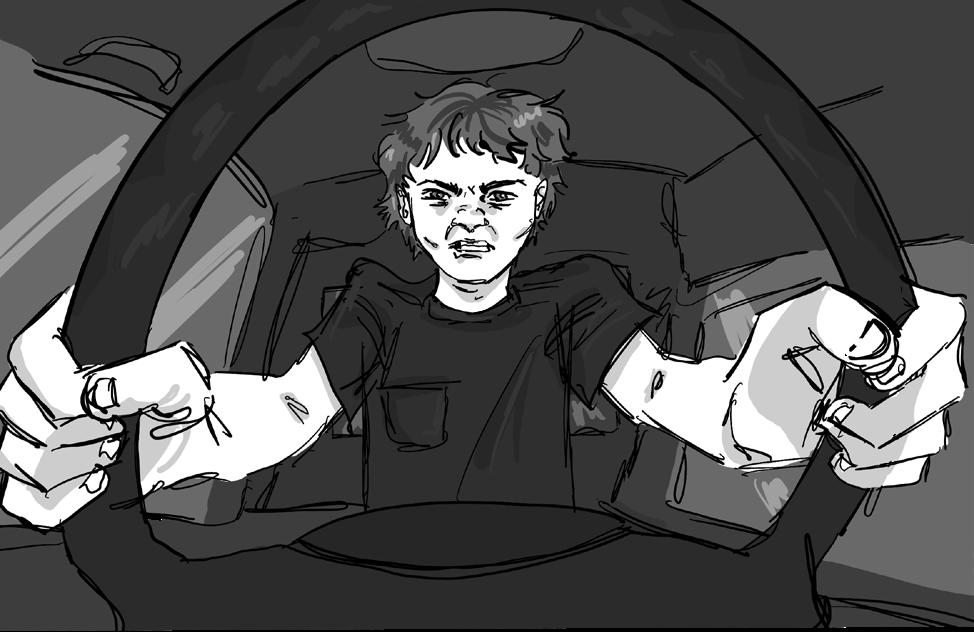
-ally expensive… But I don’t have another choice. I have to find a place to park,” Helgoe said.
For students like Helgoe, who can only get to school by driving themselves, their education is essentially put behind a paywall. The bottom line is that Samo is a public school and should not make students pay to get themselves to school. As the school continues in its phases of construction, there have been no apparent plans to add any sort of on campus parking for students. Even if Samo
can’t build student parking infrastructure within the school, they should try appealing to the city to allow students to use the civic center or use some of the budget to subsidize the Hilton lot for students.
To Samo’s credit, they have recently rolled out a new permit based plan which will allow students to park at a 4th and Broadway lot for $316 until winter break. While this offering is somewhat cheaper than the Hilton lot it is still not a great option as the lot is across the freeway and a whopping mile away from the front gate. Not only is this plan still about $100 a month, it requires a dangerous and long walk for students and, therefore, is invalid as a legit solution to student parking.
I understand how difficult it is to give students an affordable parking option near the school and am appreciative of the ways they have tried to help. However, I think there is still much that can be done to assure that students do not have to pay an arm and a leg to get themselves to school. The school can either work with the city to give Samo access to public lots, build on campus parking for students or work to subsidize nearby private lots.
The Foreign Agents Registration Act (FARA) requires groups that donate to political campaigns to disclose publicly if they are representing foreign interests. This law acts to prevent hidden foreign interests in our politics and ensures voters have an encompassing interpretation of the government’s actions. The American Israel Public Affairs Committee (AIPAC) is a bipartisan pro-Israel lobbying group that advocates its policies to the legislative and executive branches of the US government. According to aipacpac.org, AIPAC donated over $53 million to support the campaigns of 361 Democratic and Republican candidates, in the 2024 election cycle alone.

Arturo Singer-Portnoy Staff Writer
The Foreign Agents Registration Act was written to protect American democracy from foreign interference. Yet one group with unparalleled influence on U.S. foreign policy—AIPAC—has been avoiding it for decades. It raises a simple yet powerful question: why hasn’t this group been forced to register under the very law designed to safeguard us from an external influence?
AIPAC must be registered under FARA because its financial influence distorts democratic choice, its power is built on exploiting loopholes, and the outcomes it funds—from endless war to human suffer ing—are devastating.
To me, this isn’t just about left versus right. It’s about whether American citizens get the right to really know who is shaping our laws. I don’t want foreign govern ments, no matter who they are, pulling strings in secret—especially when those strings make our democracy dance for someone else. That’s exactly why AIPAC’s status matters so much. On paper, it looks like just another American lobby ing group. In reality, it operates in ways that align far too closely with the Israeli government. If we allow that influence to stay hidden behind technicalities and loopholes, we aren’t protecting democra cy—we’re letting it fall apart.
In 2024, AIPAC reported spending only a couple million dollars on direct lobbying, but when you factor in its PAC and Super PAC, the total influence effort soared to over $100 million. That kind of money shapes who gets to compete in elections, not just policy itself. This amount of influence sickens me; imagine being a congressman who wants to speak out against the Israeli government, but knowing that if he or she does, AIPAC will do everything in their power to make sure they do not get re-elected. Not only does AIPAC spend money funding the campaigns of those who support Israel, but they also give an added amount of money to the opponents of candidates who are critical of Israeli policy.
seminars,” but in practice they’re a way to sidestep lobbying rules and cement relationships that benefit Israel’s agenda. According to Washington Report on Middle Eastern Affairs, “[T]hese trips are one-sided, focusing on Israeli priorities and perceptions while ignoring Palestin-
America the brave, America the beautiful, America… the corrupt? America, a country that defies its own unbelievable democratic standards by being soured by scandal after scandal. Simply, we have a broken system.
And so, as life takes its natural course,
Liam Sauer Editor in Chief

most significantly in this context, The American Ukraine PAC and American Muslims for Palestine.
`To act like America and its relation and aid to foreign governments isn’t a core part of our place as a nation is ignorant bliss. There is a reason that foreign policy comes up during the election cycle: We are actively ingrained in the rest of the

Middle East, and American Jews overwhelmingly oppose core neoconservative foreign policy principles, the very principles AIPAC endorses. So, if only a minority of Americans support AIPAC’s positions, how can the group claim its PACs give Americans a voice? In reality, it amplifies the voice of a narrow, well-funded minority.
One of the clearest examples of the loopholes AIPAC exploits is its nonprofit arm, the American Israel Education Foundation. As a registered lobbying group, AIPAC cannot, by law, pay for congressional travel, but AIEF can—and does. For decades, it has funded trips that send lawmakers and their families to Israel for week-long tours shaped by Israeli officials. On paper, of course, these are “educational
This is why putting AIPAC under FARA is not optional—it’s necessary. It is imperative to remember that FARA wouldn’t silence the American Israel Public Affairs Committee; it would simply force transparency, exposing the foreign ties and political activity that shape U.S. policy behind closed doors.
thesamohinews@gmail.com
whose activities are directly or indirectly supervised, directed, controlled, financed, or subsidized in whole or in major part by a foreign principal.”
None of these qualifications apply to AIPAC. It is an independent organization, representing beliefs held by Americans, just like any other Political Action Committee.
PACs represent essentially every single interest group in the country. INCLUDING, the interest of a very sizable population of Americans who support American involvement and aid to Israel.
It’s no different than the Planned Parenthood Action Fund, Citizens Climate Lobby, The Pharmaceutical Research and Manufacturers of America, The National Rifles Association (NRA), and I think
Jake Phasavath Staff Writer
Flip-flops seem to be taking over our trend cycle at the moment; it’s almost like you can’t escape them. Flip-flops have been a popular footwear choice for a while. Celebrities and people around Samo have been wearing them, but should this trend continue? It seems that this once looked down upon or aversive fashion is now the norm; no one even questions it. Flip-flops should continue being a trend, and people should be allowed to keep wearing them. Most people seek comfort. Flip-flops are a staple of comfort. They can be easily slipped on, have softer textures and are

less limiting than closed-toe shoes. Flip-flops can make you feel free, but can still give you protection and support for your feet, even if they aren’t closed-toed. They are great last-minute shoes for any time when you’re in a rush. In our coastal setting of Santa Monica, the sunny temperate weather allows flip-flops to be a frequently comfortable and relevant footwear choice.
Flip-flops have a unique silhouette that can bring diversity to your wardrobe; they help it by giving you something different to wear for a change. Maybe you are going to a casual party, the store, or to an outdoor event. Flip-flops with their unique shape can teach you to experiment with your style. With flipflops, there is something for everyone. Haeliyah Henry (’26), a student who commonly wears sandals or other open-toed shoes like slides, discusses her enjoyment of the shoe.
“I like how soft they are,” Henry said. “You can make a statement when wearing flip flops, like wearing them with a suit.”
Even with all the pros of flip-flops, some people are still averse to them; some people may think it’s unhygienic or even
The new, short-sighted, regime of MAGA isolationists will have you believe otherwise. But what happens in Ukraine, what happens in the Middle East, affects America. We have a vested interest in the safety of our allies in Western Europe, just as much as we do in the stability and function of our allies in the Middle East.
This is not a support of what AIPAC is doing. It’s a support for its right to exist. There is a reason that we have lobbying in the United States. It’s so that individuals with beliefs on our government’s action at home and abroad can have a represented voice. Without lobbies, issues would be completely slumped under the rug by politicians who simply don’t feel like putting focus on them.
My biggest fear is that if we label every lobbying group that focuses on our policy towards other nations as Foreign Actors, what happens? Do we really think that integral Ukrainian support, which is increasingly plummeting, will actually continue in congress if there is no American Ukraine PAC?
Even if you despise AIPAC, you have to acknowledge that there is a place in our democracy for groups advocating for a
I wholeheartedly agree that lobbying has too far of a reach in our government. I agree with restrictions on how much PACs can invest in politicians. I believe in reforming how much organizations can influence our elections. But that’s a different question.
Putting AIPAC under FARA goes against the law. And, I think if those that want to are being honest with themselves, it’s ideological disingenuous. If you support our right to have a voice in our democracy, even if you are against the actions of Israel, you don’t support AIPAC being put under FARA.
thesamohinews@gmail.com
just weird to have your feet out in the open. Many people, even today, will give you a second glance if you wear any type of open-toed shoes. Finn O’Brien (’28), who has been wearing Crocs and flip-flops for a while and considers themselves an enthusiast of open-toed shoes, comments on the reactions flip-flop wearers get.
“Some people definitely have an aversion to it, especially if they aren’t wearing socks with flip-flops,” O’Brien said. “[But], I think they are prioritizing comfort and ease of use and I think that´s a great thing to be doing, definitely with footwear.”
Flip-flops may be seen by others as only a seasonal shoe, but they can be worn year-round. Your outfits have room for flipflops and they deserve a spot in our trend cycle. Flip-flops are a staple of comfort; they’re convenient and they are very fashionable and easily styled with almost anything. Flip-flops are a fun and essential shoe and should stay in rotation.
Ashley Tan Staff Writer
Entering the ’25-’26 school year, most Samo students are already used to storing their phones away for when class is in session. But many may notice that instead of having only a handful of phone-free classes like last year, phones must now be put away in every class. This is because the Santa Monica-Malibu Unified School District (SMMUSD) has implemented a policy which restricts electronic devices during academic hours. Starting this school year—what was once up to teachers is now a district wide policy.
The BP 5131.8: Mobile Communications Policy serves as a solution for many problems that were reported by teachers and parents regarding students’ use of phones in a learning environment. SMMUSD defines electronic devices as any cell phones, cameras, iPods/MP3 players, laptops/tablets, portable speakers, handheld electronic games and headphones/earbuds. Many agreed that the overuse of technology in a classroom can lead to distractions, anxiety and overall lower academic performance. In 2025, the National Center for Educational Statistics (NCES), found that more than half of public school teachers believe that cellphones have a negative impact on students. Along with this, 77 percent of public schools have policies to prohibit cell phone use during class, and within them, 38 percent prohibit cell phone use during the entire school day.
Samo students are now only allowed to use their electronic devices during non-academic periods, or “free periods”. Many students have found that having to put their phones away in every class can lead to many problems.
Samo student and athlete Alicia Chow (’27) has concerns about not being able to quickly reach her parents in the case of an emergency. Since most teachers use a pocket chart for phone storage, especially for students who sit far away from it–that their phones will not be within immediate reach.
“I think that the phone policy is both inconvenient and dangerous, especially with school shootings becoming increasingly common,” Chow said.
Chow also believes that the attention of a student should be up to the student, not the school.
“Students would not be on their phones during class time if they took their education seriously, which is their choice,” she said.
In contrast to Samo, middle and elementary school students in the district must store their phone away for the entire school day. Many incoming freshmen are adjusting to the high school phone policy, which is relatively more flexible when compared to the middle schools’. Sasha Lu (’29) is one student, who has come
to Samo from Lincoln Middle School.
“I don’t think it’s that bad, especially com
pared to Lincoln since we couldn’t use our phones at all,” Lu said. “I prefer it [the Samo phone policy] now ‘cause I think it makes it easier for submitting assignments if you could take a picture of it. Cause on the laptop it’s laptops, it’s kind of more difficult.”
Regardless of outside opinions, SMMUSD would have had to implement a restrictive phone policy either way because of California’s Phone-Free School Act. Signed by Governor Gavin Newsom on Sept. 23, 2024 the legislation requires every school district, charter school and county office of education to adopt a policy limiting or prohibiting the use of smartphones by July 1, 2026.
Although the district’s approach to limit students’ screen time may seem extreme, it could have been more severe. SMMUSD considered having students store their phones in magnetically locked pouches for the entire school day. Samo student Hailey Castanaza (’26), the current Student Member of the Board, played an important role in the creation of the district’s phone policy. Knowing that it was something that affected all students, she brought in Dr. Dusan from student services to her ASB class so that he could receive student feedback and opinions. The students immediately pushed back on the idea of storing phones away for the entire school day.
“He mentioned having the phone pockets and the whole class was against it. We definitely understand that we need to put our phones away during class because it’s a distraction, but [we] don’t think that we need to put our phones in phone pockets all day,” Castanaza said. “We should have it from class to class [and] during lunch.”

Student seen placing his phone into his teacher’s phone pocket.
Castanaza also believes that her education has not changed with the new policy, since most teachers had students put away their phones throughout the ’24-’25 school year as well.
“I don’t think it’s impacted my learning at all. I think last year, even without the official policy, it was kind of the same,” Castanaza said. “I put my phone away for certain classes because teachers were requiring that we weren’t on our phones. Or [they] told us after the first offense ‘We’re gonna take it to the house office.’”
thesamohinews@gmail.com
What is one question you would ask a senior for advice?
Audrey Stephansen Staff Writer
Freshmen come into Samo bringing lots of new excitement, energy and spirit. The transition from middle to high school can be a big change for some, and freshmen have many questions to ask as they embark on their new high school journey. As seniors launch into their fourth and final year of high school, the lessons they have learned can provide valuable insight for the underclassmen.


“One question I would have for upperclassmen would be, what courses they would recommend, specifically for AP classes, in terms of what has a lot of coursework, and what we should not take if we are really busy?”
-Kiana Sadrieh (’29)

“I would recommend that if you don’t want to take any time-consuming APs, stay away from the science AP. If you want to take some easy APs, elective APs and English APs are considered less difficult. All APs are difficult, but compared to some other APs that are offered those just tend to have a lower workload.”
-Arman Chibber (’26)
“One question I would have for an upperclassman is how do I get used to the bell schedule if it is constantly interchanging?”
-Daniel
Friedman (’29)

“Adjusting to the bell schedule can be difficult at the beginning, but after a while you get used to it and [the schedules] are only three different times,” Gaitan said. “Another thing that helps is to download this app called Saturn, and every day it tells you when your class starts and ends.”
-Crystal
Gaitan (’26)




“I think generative AI is harmful. I believe it’s bad for our minds, it’s bad for the environment, it’s stealing work, and it’s threatening jobs. Kids, while in school, need to be developing skills to do research on their own. While AI as a whole does have some benefts, the way it’s being used currently is not for the better of our society.”
- Maia Anderson
(’28)









“I’m deeply concerned about the environmental cost of AI. It’s taking resources that we can’t get back, like water, and it’s also impacting communities disproportionately. So, areas that have less resources are more heavily hit than other areas that have more resources. Te electricity use is extremely alarming.”
- Amy Bouse, Visual Art teacher








“I despise AI. I think that it’s really terrible for the environment. It ruins people’s perception of reality. I don’t think any use of AI is worth it at all. It’s killing creativity, and it’s also not even that smart. It uses stolen art to generate images. I think it’s plagiarism of other artists’ things that have already been created.”
- Evan Walker (’28)



thesamohinews@gmail.com
Lily Edwards Staff Writer
Te digital era has fully consumed this generation and ushered in the desire for extreme convenience. Food delivery apps, online shopping and Artifcial Intelligence (AI) overviews were all made with the intention of saving time and efort, but most of all, streaming platforms allow access to thousands of movies, TV shows and music on demand at any time. All this entertainment at our fngertips has created this illusion of security, that art can no longer be lost, as it lives forever in digital form. Tis infnite record of media that the internet has allowed us to generate appears to be clean, compact and convenient. But this doesn’t invalidate the importance of collecting and preserving art; if anything, it enhances the value of physical copies.
Physical media is something you can truly own; a material object that can be held, cherished, and loved. Purchasing a subscription to a streaming service provides the impression that the buyer owns all the media on the platform. It allows them to listen to or watch countless pieces of art over and over again, and enjoy every last second, until all of a sudden, the rental expires or a favorite song or movie is randomly removed from the app. On Nov. 11, 2022, the beloved Bladee album “Ice Dancer” was removed from Spotify due to issues with Distrokid, the music label it

was distributed by. Fans were up in arms about the fact that they could no longer listen to their favorite songs like “Waster” and “Side by Side”. Te situation reassured that streaming music is practically leasing with no guarantee. You never truly owned the art at all; instead, a corporate middleman was holding all of this media in its iron fst. Buying a CD or a DVD gives the art a permanence that was not there digitally; it helps preserve it for the ages, as well as acting as a bridge between generations. Rosalie Tsirlin (’26) shares her experience with the impermanence of modern media. “ Teres some records that I have that are pretty old, from the 40s and the 50s, and I try to fnd the songs online and I can’t,” Tsirilin details, “So the only way I can listen to it really is from my record player.”
Physical media is ofen passed down from parents to children, thereby introducing a new age group to artists who were popular when they were teenagers. Ownership
Across the world, ficial intelligence(AI) topic. With language like ChatGPT or DALL-E becoming ular, it is hard for an opinion on it, is no exception. Considering nuances that come million different have. This could range on where and when if the writing and
of digital media is a complex, layered and nuanced business process which is o unclear to the consumer. Buying a movie on any streaming platform doesn’t ensure lifelong ownership the same way that owning a physical copy does. Streaming has also led to new waves of mass censorship like never before. Cut ting controversial scenes or removing entire episodes from a platform has become far more common these days. Although some restrictions like this are caused by national media laws and government regulations, streaming platforms are just as complicit in this issue. For example, in mid-October of 2024, viewers noted the removal of 19 Palestinian-made flms from Netfix’s library.
this on an expired three-year licensing deal, it calls into question why Net 300 billion dollar company – chose not to renew the license. have been their intention, removing these flms aligned them with a certain political stance, and no matter what their political views are, the media they stream should remain universal. Purchasing physical media helps negate this censorship; owning DVDs allows the viewer to enjoy art as the creator originally intended, and under stand the initial message and meaning behind the piece instead of a manufactured and watered-down version. It creates the option to have a more authentic viewing experience, therefore removing the distance between the artist and the consumer.
Samo student Fiona Schweig (’26) shares her perspective on listening to vinyl over streaming music.
“If I’m at home, and I put a record on, I put it on deliberately to listen to that album in the order that the artist put it in, and I think that makes you pay more attention to the message behind the music.”

Film and music are both forms of media that capture the complexity of humanness and human sentiment, so stories and memories can be tied to physical objects far more easily than they can to digital ones. Media like CDs, DVDs, records, Blu-rays, etc., are items that can and ofen do hold emotional value. Take the Criterion Closet, a series started by infamous DVD distributor Te Criterion Collection. show allows people to sit down and watch their favorite actors, directors and celeb rities browse the endless discs that Te Collection provides, and select and discuss their favorite movies of all time. Te entire concept of the series and what makes it so popular revolves around the connection between human experience and art. With streaming platforms paying out pennies in residuals and generative AI be coming an encroaching threat to artists around the globe, buying physical media has become more important than ever. Creative jobs within the tries, like storyboarders and voice actors, are already being replaced by generative AI, and even popular songs and memes on social media are fully machine-generated content. Shweig highlights the importance of purchasing physical media during a trivial time for modern artists.

“Directly supporting an artist that you really enjoy by purchasing vinyl from them is a good way to show your support and actually help them progress.”
Tough it might seem minuscule right now, this issue will only grow with the continued training and use of these AI platforms, and one of the few ways to combat this is to further our consumption of physical media. Purchasing these items directly profts the creatives behind your favorite media and supports them at a time when their livelihoods are at stake.
Ultimately, owning and collecting physical media is a way to preserve music and flm in a more meaningful way. Shifing away from cold, corporate streaming ser vices to DVDs and CDs allows for a more intimate relationship with art and enables one to objectively and outwardly showcase their interests.
thesamohinews@gmail.com


e Lunch Bench*

the subject of artiintelligence(AI) has been a hot language learning models image generators like becoming increasingly popanyone not to form and Samo’s campus
Considering all of the come with AI, there are a takes a person could range from thoughts when AI should be used, imagery it produces -

“I think AI is formidable. From the student per spective, there’s a particular platform I likenpoiD called Class Companion. I feed the AI multiple rubrics, my own narrative comments, models that are good, models that aren’t good. I’m able to give feedback a lot more quickly.”


- Jordana Benone, English Teacher




“AI is a really fun thing to use to, well, have fun with. Sometimes my friends want me to use AI to combine two things together to make an image. For example, my friend Gus wanted me to make an image of him as Megamind, and that was pretty cool. (But) For something to be considered real art, I think it has to have feelings, and AI doesn’t have feelings since it’s a computer.”
I think AI is benefcial to our community because it’s bringing us into the future. AI is an invention like never before. I think that it’s important to use AI in school in the right way because it’s the key to our future. I would say that (when using AI) we are able to advance our understanding and comprehension of things and our problem-solving skills are aided directly.


- Waylon Cox (’27)


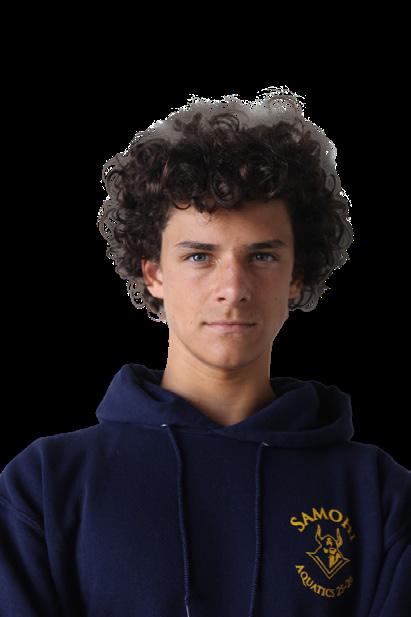







Mental health tolls, climate costs, and more; the untold truth of AI’s impact.
Devyn Hamilton Staff Writer

Now that Artificial Intelligence (AI) software has been in the public eye for almost three years, the conversation has begun to turn from short-term effects–ease of its usage, inaccuracies on AI chatbots’ parts and inauthentic submissions of work–to issues regarding long-term effects on humanity. Younger generations’ brain development is especially at risk, as well as the speeding issue of climate change worldwide, if AI usage progresses as it
As for outcomes of AI in school settings, a big concern is that teachers no longer get their students’ genuine work. High school takes place during a formative period of life in which habits start to get solidified in the brain and it’s crucial to develop critical thinking and emotional skills that AI may chip away at. Samo AP Psychology teacher Charles Thun commented on how students used AI in past years before teachers were able to track usage.

“I think some of the students were just solely having AI do everything for them and it was really detrimental; they had no idea what they were learning–they weren’t learning anything,” Thun said.
Youths’ long-term mental health struggles alongside the usage of AI chatbots has also been revealed as a major liability. This past year, Adam Raine’s death on April 11, indicated that these technologies have already formed lasting impacts on mental health. Adam Raine was a 16-year-old who opened up to his personal ChatGPT bot. This chatbot ended up aiding in Raine’s suicide and convincing him not to tell anyone else about his depression. Teens and young adults are statistically very vulnerable to mental health issues, and Raine’s suicide has brought up heavy discourse that chatbots need stricter limits and harsher regulations. As this case sticks out as evidence that youth are at risk with certain parts of this
As well as emotional damage, AI may also affect logical thinking skills in the human brain. A study from Massachusetts Institute of Technology (MIT) was conducted on 54 people aged 18-39. They were split into groups and wrote multiple SAT essays using either Chat GPT, Google’s search engine, or no outside sources, based on their group assignment. Their brain activity was monitored during each essay writing session and researchers found that the group using Chat GPT underachieved significantly in comparison to the other groups in brain activity and became more careless with their essay production over the course of the study.
“We’ll get adjusted to AI over time and learn how it’s helping us and hurting us and try to steer away from the harms… we have a human tendency, though, to be kind of lazy, so we’ll have to really take a true stock of it–how it’s helping us and hurting us,” said Thun.
For students who want to continue on to college, getting good grades is often held more highly than being interested in or really understanding the work. Students who use AI

chatbots to help them with work can become reliant on it, and when college application time comes, they may use these chatbots to answer PIQs and help with essay writing. Ernesto Flores, a Samo college and career counselor, shares his opinion on AI’s role in college applications.
“I do personally feel that the essay component [of the application process] is something so important because it allows students to use their voice to literally talk about themself,” Flores said.“The key thing there is ‘their own voice’, to try and personalize it, so though AI may assist students in getting ideas down, I’d hope that students aren’t relying on it…the genuineness of their own voice, thoughts and experiences may not be relayed if students are using AI.”
In recent online conversation, AI’s effects on the environment have also become a leading source of discussion. Currently, there are no regulations around AI companies disclosing their energy and water consumption, so AI organizations tend to be broad in statements about the amount of water the technology uses up. The FAQ on OpenAI doesn’t include any information about water or energy usage. Shaolei Ren, an engineer who is currently an Associate Professor at University of California, Riverside, was pushed by the lack of clarity on the topic to personally hire a team and find out how much water ChatGPT-3 took up. Ren’s team estimated that hundreds of thousands of gallons of freshwater were used to train the model. A different company, the Grainger College of Engineering’s Center for Secure Water, also had findings that were about 550,000 gallons of water per day, with daily usage. Recently, many policymakers worldwide and in the country have called for assessments from the National Institute of Standards and Technology (NIST) surrounding AI’s effects on the environment. With scientists predicting that the world has less than a decade left before the worst effects of climate change become irreversible, the introduction of AI to this equation brings bad implications for the planet. Bigger issues are arising in AI usage from environmental, emotional and psychological standpoints. This technology has become more widely acknowledged as a potential danger to hu mans, as well as an aid. AI has encroached on educational life and may irrepara bly impact ecosystems, which has caused some to call for–and continue calling for–stricter

thesamohinews@gmail.com


Hope Wang Staff Writer
As Homecoming week unfolds, the excitement spreads through campus, beginning with the Homecoming Carnival on Oct. 8, where students gather for games and food. The carnival precedes the football game on Oct. 10, which all leads up to the long-awaited Tangled up in Hoco dance on Oct.
11. ASB’s Activities Committee is organizing this week of spirit, led by Lilah Pantallion (’27) and Chase Noble (’27). Dance decorations have been inspired by the film’s wellknown themes of lanterns, colors and warmth. Students can expect music from a DJ, mul tiple photo booths and expanded casino tables. Pantallion explains what the committee has been doing to prepare for the theme.
“We tried to listen to what kids really liked last year, and then we asked what they would prefer for music, food and activities,” Pantallion said. “The dance will have a lot of warmer lights, lots and lots of soft lighting. The color schemes will include purple, white, gold and things like that.”

When it comes to the dress code, the most import ant thing is to wear whatever you are comfortable in. Students often wear dresses of all lengths, suits, button-downs, or even more casual attire. With the theme as Tangled, stu dents can lean into the purples, yellows and whites in their outfits, taking inspiration from the film’s fairytale setting. Still, there are no strict rules, and students are encouraged to add their own personal style. Noble emphasized that the theme shouldn’t limit students’ choices; it’s more of a guide, and outfits do not need to match. The dance should be an opportunity to express and have
fun with your outfits.

“I don’t think the theme really matters when it comes to what you want to wear,” Noble said. “It’s more about choosing what you like and feeling comfortable in
ASB students are working hard to put the together. Tickets became available on Sept. 24, and prices are lower in the initial stage of purchases or with an ASB card. Noble encouraged students to just have fun and enjoy the night.
“We really just want everyone to have a great time and make memories with their friends; it’s all about enjoying yourself,” said Noble.
thesamohinews@gmail.com
Yaretzi Preza Staff Writer
As a new school year emerges, students at Samo are beginning to prepare for the fall season. What was once an iced refresher has turned into a pumpkin chai latte, and although the California heat is at its peak, many cozy fall trends have started flooding social media. Fall culture has many significant components, but the ones that are essential to experience a snug fall are food, trends, activities and entertainment.
Introducing the season with a classic element—homebaked goods to share with all. All it takes is one fresh breeze to pass by and all of a sudden, a gooey batch of cinnamon rolls sounds like a good idea. Long-awaited such as pumpkin cream muffins or apple crisps have already started appearing in grocery stores ev erywhere. Talking with students around campus that love to step into the kitchen during fall, Mason Eissa (’26) expressed his passion for baking and drinking his morning chai tea.
“Me and my mom like to bake pumpkin bread during the fall season, we do it one time every year.” Eissa said. “And I usually go to Starbucks everyday to get a pumpkin spice drink if they have it. But right now, I get a chai and sometimes I’ll get a croissant.”
Fall food:
• Cinnamonrolls
• Pumpkin chai
• Pumpkin cream muffins
• Apple crisps

• Watching Halloween movies
• Baking goods
• Making personalized cof fee
• Being cozy with loved ones

Showcasing a new pair of Uggs and digging out that thick Carhartt jacket that has been hidden in the closet too long, students are equipped to make their first fashion statement. As a sophomore preparing for the fall season, An Le-Nguyen (’28), shares some of her inside tips and tricks she utilizes to help stand out during fall.
“I’m going to wear more jackets. I’m ex cited to wear my feather jacket and pair it up with baggy jeans.” Le- Nguyen said. “I think staying on the theme of brown cloth ing is essential to begin fall.”
Fall trends:
• Brown color palettes
• Uggs
• Long sleeves
• Boots
Whether it’s playing board games at family re unions or smiling for another family photo that will be framed in two weeks, fall activ ities bring more com fort than ever. Samo student, Samatha Me dina (’26) shares her enjoyment of hanging around her house with her cat, Percy, in her free time away from her busy schedule.

In the rise of nostalgic me dia, mellow songs and com fort shows are more essential than before. Walking in the buildings of Samo, students are often tuned into music, hypnotized by their musical genre taste. Apart from redownload ing the Smashing Pump kins radio, other students turn to the whimsical side of movies. It’s no surprise some students unwind for bed while Harry Potter plays in the back ground; it’s almost like a second home to Olive Rosenberg (’27), who shares her love for watching the famous film series during the fall season.
“I love watching Harry Potter because it gets me in the mood,” Rosenberg said. “It makes me feel very nostalgic and homey.”
Fall entertainment:

“I sit down in my chair with my cat just scrolling through social media or reading a book,” Medina said. “I always cuddle with my cat. She follows me everywhere.”
Fall activities:
Jefferson Tinus Staff Writer
Devonté Hynes, better known as Blood Orange, released his newest album, “Essex Honey,” on Aug. 29. This record is his first major release under the Blood Orange name since 2019, and with it, Hynes takes listeners on a journey through the of grief and resilience in the face of change.

I use the word “journey” quite intentionally because it’s the best way to describe the unique, experimental structure woven throughout the album. Songs on “Essex Honey” shift like tides ebbing and flowing as tracks build, transform and recede. For instance, one of the many songs that reflect this sonic journey throughout the album is the secondary track, “Thinking Clean.” It begins with simple piano chords and vocals, then layers in a cello about a minute in, expanding midway through with drums, which are suddenly taken away as the song is stripped back down to a cello solo for an outro. This experimenta tion is combined with a atmosphere to provide a sound for Hynes, a natural progression from previous albums.
ica fusion while “Negro Swan,” his most acclaimed album, dialed back for a Lo-fi R&B effect. Essex Honey combines aspects of these many genres, in addition to new themes and topics, to strike a wonderful balance. It achieves a groundbreaking sound that doesn’t stray too far from its musical roots.
Thematically, Essex Honey dives into the perspectives of people affected by loss. This theme reflects the emotions experienced by Hynes after losing his mother to cancer in early 2024 and returning home to be with her in her final days. In his grief, he goes back through early memories and revisits places dear to him.



Hynes’ debut under the Blood Orange name, “Coastal Grooves,” leaned heavier into an R&B electron-
Songs like “The Last of England” show his feelings towards this loss with the final lines stating, “Time has made it seem we talk / But then they took away.” Lyrics like this, in addition to recurring lines throughout the album, state, “I don’t want to be here anymore,” indicating the despair of Hynes at this time. Throughout the album, his emotional highs and lows are displayed through similar lyricism helping listeners understand his grief process. This process is shown to not be one of a linear path, but more as a journey he travels through with many changes and setbacks that intertwine with his progress in dealing with grief.
Public opinion of “Essex Honey” is fairly positive from most sources. Will
Dukes from Rolling Stone praised the album, giving it 4/5 stars. “Few albums are this emotionally refined, giving us a real sense of grief.” Dukes continues on to discuss how the themes of loss were handled in such a way that it made the small moments in life feel important. Pitchfork, with a similar rating of 8.1/10, discussed a “liminal feel” heard through the music on the album and appreciated Hynes’ unique portrayal of his past and upbringing. On the other hand, viral music critic Anthony Fantano ranked it more in the middle, giving it a 6/10. “I wouldn’t really say there was anything on this album that I would skip or came across as offensive or sloppy or overly mediocre,” Fantano said. “There was only so much of it that grabbed my attention and kept me locked in, immersed, and even entranced.”

Though, beyond these reviews, the album connected with me as a listener on a level that is hard to describe aside from what has been said so far. I wholeheartedly recommend “Essex Honey” to all music lovers who want to experience this nostalgic journey filled with wondrous experimentation and emotional depth.
thesamohinews@gmail.com
Opal Feves Sports Reporter
It has been too long since the last major claymation release. After multiple successes such as “Fantastic Mr. Fox”, “Isle of Dogs”, and “Shaun the Sheep”, not to mention the three top-grossing stop motion animated movies: “Chicken Run”, “Wallace and Gromit - The Curse of the Were-Rabbit”, and “Coraline”. Since these major releases, there haven’t been any new hits in the genre in recent years. Despite many films made with clay animation achieving success and the inherent ap peal of a style so different from what is usually seen in animated films, clay animation has been noticeably absent from recent releases due to film studios’ preference for easier methods of filmmak ing. Filmmakers are abandoning the art of clay animation in exchange for faster profits using technology such as Computer-Generated Imagery (CGI). By making this switch, they are sacrificing both creativity and integrity for money.
The art process of creating animated movies using clay figures and stop-motion photography first emerged in the late 19th century after the invention of plasticine clay, a type of modeling clay unique for its plasticity (stretch). Claymations’ first screen appearance was in the 1908 short film “A Sculptor’s Nightmare”, and by 1926, the first full-length claymation film was made, called “Long Live the Bull”. After these initial projects, claymation faded from screens until animator Will Vinton officially named the film style “claymation” in the 1970s. This caused a revival for claymation within the film industry as Aardman Animations created the well-known Wallace and Gromit characters, who have starred in multiple claymation films.
element, as each second of film is the result of at least twelve tiny adjustments to the clay figures. This could mean that a day’s worth of adjustments could culminate in only five seconds of footage. With this level of time-consumption and costly production, CGI is increasingly taking the place of claymation as it’s able to render simple scenes in a matter of minutes and longer high-end scenes in only

With computer imagery becoming much more accessible and easy to use, claymation has been pushed to the back of the film industry, begging many concerns about studio’s prioritizing profit over authenticity. Claymation is yet another art that we are losing to fast-developing technology, and raises the question of what art will be taken over next. Technology is certainly a great achievement, but it is also affecting the originality and creativity of real art and is killing industries.
One of the biggest factors for the long periods between films is the amount of time claymation takes to produce, with full feature films taking anywhere from four to seven years. Oftentimes, hundreds of models will need to be created for each
Devyn Cheah Staff Writer
President Donald J. Trump has openly expressed his disdain for any historical artworks that don’t appeal to his own biased and offensive ideals. Trump’s recent actions involving removing funding from museums like the Smithsonian Institution show his plan to move the country towards a dictatorship where the media is controlled through censorship and political management of the arts.
Trump made his intention of limiting freedom within the arts clear in his first term back in 2017, when he called for the termination of the National Endowment for the Arts (NEA) organization. This organization has been functional since 1965 and has given $5.5 billion in grants to multiple arts organizations and museums since its inception. I’s an independent federal organization that is the single largest funder of the arts and education. By trying to terminate the NEA, Trump indirectly and purposefully will shut down many museums that represent minorities’ art and museums focused on artistic political commentary.
AP Art student, Kiera Jenkins (’26), shared her opinion on the topic. “I think that the arts are very connected to freedom of speech, so I really don’t think it should be controlled,” Jenkins said. “If it’s not targeting a certain group, it shouldn’t be monitored.”
Historically, the beginning of a repressive system has been marked by leaders who attempt to manipulate visual or performative arts. This is done to alter the public’s thinking in ways that align with specific political belief systems. For example, China’s Cultural Revolution, as recently
as 1966-1976, showed how effective censorship is when trying to control a population. Mao Zedong, China’s communist leader, attacked certain pieces of art and literature because they didn’t fall under his standards. His censorship even applied to specific people, as Zedong imprisoned artists such as Mu Xin who made opposing works. Xin made works that recalled the past–something strictly against Zedong’s regime. An example is “Reciting a Tang Poem on the Road to Shu,” which referenced the near-death of the Tang Dynasty. As a response, he was treated as a threat to society and put in jail. This extreme example of censorship shows how the criminalization of artists is a dictatorial tactic that the public must be aware of.
Alana Rivera (’13), Samo’s English, Freshman Seminar and AP Government teacher, commented on how control of the arts contributes to a tyrannical political system. “[Controlling the arts] can be dangerous because if we’re allowing one person’s bias to decide what is allowed to be in museums, that is never a good idea,” Rivera said. “People have different interpretations of times, periods, even the same moment, so allowing people the space to interpret how they feel about art is important.”
Museums are supposed to be col lective spaces of art and literature that mark moments or emotions throughout history. Art, in the context of history, is one of the clearest and most timeless portrayals of how individual demographics felt about any given situation. The censorship of media both removes select perspectives
from history and gives viewers fewer opportunities to think for themselves. The administration’s goal in defunding museums is to force museum-goers to adopt a skewed perspective on the “rightness” and “wrongness” of groups in history.
The White House’s official website includes Trump’s executive order that states his quarrel with many modern museums. He implies that modern museums are forcing guilt and false blame on early American settlers and citizens, therefore making modern Americans feel resentful or negative towards their country’s history. “Museums in our Nation’s capital should be places where individuals go to learn — not [places] to be subjected to ideological indoctrination or divisive narratives that distort our shared history.”

Trump accuses multiple museums, specifically calling out the Smithsonian of showcasing an unusual type of alleged “revisionist history”.This is a term usually used to describe acts of whitewashing or sugarcoating history, often because of extreme patriotism. In this case, Trump claims that these museums make America look “inherently racist, sexist, oppressive, or otherwise irredeemably flawed,” according to his executive order.
Citizens in favor of Trump–generally the Make America Great Again (MAGA) division of the Republican Party–are often in support or unaware of these actions. It’s important to note that museums and arts aren’t just being defunded if they support an Indigenous, Immigrant, African American, or Asian
While it may be easier and faster to produce films using CGI, it takes away the joy and unique nature that makes up claymation. As a child, there is something fun about seeing a movie that reflects some grit and real-world imperfections. Claymation movies evoke such a feeling of connection and genuine feeling. Each claymation movie reflects the artists behind them’s creativity and love for the medium. Recent CGI films don’t have the level of care, dedication, and love poured into them as many of our favorite childhood films do, and it’s important that we recognize the decline of real creativity. Claymation was never supposed to be the smoothest form of film, but we still showed up to watch it, inspiring many to make home shorts and discover stop-motion animation. Claymation decline is another way we are losing some ingenuity and creativity in our lives and it’s becoming increasingly important to recognize that.
thesamohinews@gmail.com
perspective of the country. These actions defund factually correct depictions of American history that have been discussed for decades–or even centuries–not just for the past couple of years. The Jackie Robinson memorial has been up since 1997, and was removed from the Department of Defense’s (DOD) website last March on the basis of clearing out Diversity, Equity and Inclusion (DEI) from politics. This memorial simply highlights an important Black baseball player–completely unrelated to arguments around art being spewed by the Trump Administration. The page that was up about Robinson mentioned his service in the army and his participation in the Black Panthers during the Civil Rights movement. The Black Panthers were a Black Alliance association that fought against Jim Crowmlaws and injustice. By removing this memorial, Trump is actively denying the Civil Rights movements importance, denying Robinsons admirability and denying that he was a revolutionary baseball player.
While American history is not always pretty, it is highly important to recognize the country’s faults to grow–growing is true patriotism. Trump would rather sugarcoat the past and brainwash American citizens into believing the country is currently perfect and the nation’s history is perfect. “Perfection” in his eyes is creating institutionalized disadvantage–removing the rights of people against him, making it harder for minorities to obtain jobs and taking away their voices. Defunding museums like the Smithsonian silences the voices of so many speakers and erases them from history. While the Trump administration rolls out more and more horrifying acts, every citizen must fight these continued injustices with individual power.
thesamohinews@gmail.com
Anna Ross Staff Writer
Samo’s dress code allows students to express themselves through a multitude of fashion styles. With a broad mix of sweatpants and hoodies, flipflops and shorts, jean jackets and boots and everything in between, students have the freedom to wear whatever they want. Some even design, sew, stitch or crochet their own hand-tailored clothes to wear anywhere. Around school, throughout the grades, students who create their own pieces of clothing, shared theyre process and love for the art.

“I’ve been crocheting for around four years now, but I only started making clothes around this year. I really enjoy the practice of doing it.I find it to be very calming, and it’s also really nice to be able to create something perfectly for you. The process takes a while, though; sometimes you can just freehand things, but then you have to get all the yarn for it. Then after that, it’s just kind of time-consuming to make.” - Eila Lee (’29)
“I take a lot of inspiration from nature and whimsical things, and also just being able to take old things and make them new again. Step one is always finding the vision. You’ve got to find the vision first. Sometimes, when I look at something, it’ll just come to me. It’s like, you see something and you see what it could be in the future. Step two is planning out the process. ‘How are you gonna do it? What pieces are you gonna take to turn into new things?’ And then, step three, bring out the sewing machine: cut it up, sew it, and, yeah, then you basically just piece it together until you have what you want, and boom, you’ve got that new item. My favorite thing that I’ve made is probably my jean purse, which I carry all my stuff in. I wear it every day.” - Sophia Luneva (’26)

AP Art is one of Samo’s hidden gems. Students of all skill sets, backgrounds and ages are able to come together to create complex and extremely personal portfolios over the duration of the school year.
The AP Art class has one main requirement: artwork must be exclusively 2-D work. Besides that, AP Art is one of Samo’s few classes that allows students to have full creative freedom. This means students can run wild with their ideas; how they achieve their end results is up to them. On average, two assignments or prompts are assigned weekly. A recent example of an assignment requirement was simply to include a plant in the piece. This broad theme made it so students could produce works that ranged from characters with plants for heads to a street with plants running down the sidewalk. AP Art students can choose to work with any media they want, whether that be pens, pencils, markers or paints; these students’ artistic freedoms are boundless.
Over the course of the year, students are to create a 29-piece portfolio that will be submitted to the College Board. Due to art’s extremely personal nature, the grading system is based on criteria such as completion, creativity, direction following and effort. AP Art is a class unlike any other because it values all differing art styles. The class goes beyond labeling art so shallowly as good and bad.
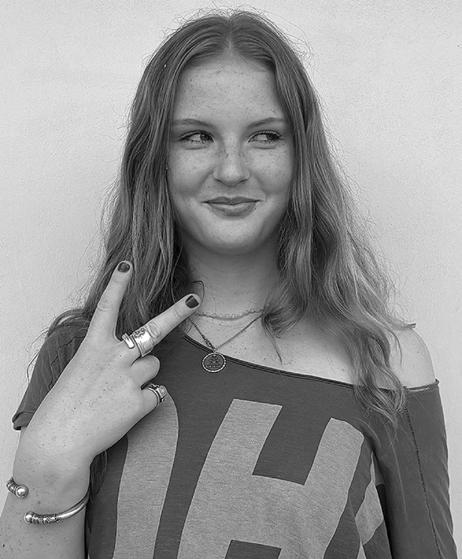

“I really look on Pinterest a lot for inspo, as well as magazines and books. I really like to look at them and see different styles, colors and patterns. I learned how to sew during the pandemic, which was fifth or sixth grade. I use a little embroidery hoop and a bowl of beads. I sew while sitting on my bed and watching something so it’s relaxing. Recently, I made this tank top that I really like. It’s a white tank top, and then it has like flowersatter, and some little gems on it.” - Josephine
thesamohinews@gmail.com
One reason AP Art differs from other APs is because of the exam. AP Art students will submit 15 of their 29 year-round pieces. These pieces cannot be picked at random, but instead, each must fit the requirements of the sustained investigation. The sustained investigation is an overarching theme that all 15 art pieces submitted for the AP Exam must follow. Students are able to choose their sustained investigation topic, which can be anything the artist desires, ranging from mental health to world travel. Each piece submitted must be accompanied by a paragraph explaining the artwork to the sustained investigation.

Cecilia Fierrro-Feinstein (‘27) explains, “It’s important to choose a unique [sustained investigation topic] that captures the College Board’s attention,” Fierro-Feinstein said.
AP Art is more than just an advanced class; it’s a space for self-expression, experimentation and growth. Students leave this course with not only completed portfolios but also a deeper understanding of their own voices as artists. Through balancing creativity and discipline, AP Art prepares students for college-level expectations while highlighting the individuality in every brush stroke, line, smudge, sketch and design.
thesamohinews@gmail.com
On Aug. 28 - Sept. 1, on Labor Day weekend, the Chamber and Madrigal Choirs went on their annual retreat to Camp Wittle in the tall mountains of Big Bear as part of their yearly tradition.
The goal of the retreat is to build community in the choir for all students and the teacher and to develop teamwork skills. It provided students with uninterrupted time to rehearse songs and refine musical knowledge, preparing singers for the upcoming year.
Throughout the trip, the Chamber and Madrigal Choirs split up into separate groups during rehearsals to work through songs or exercises. Even if they misstepped on a single note, they had to start over again in order to perfect their songs and dive deeper into the technicalities of the lyrics and rhythms.
Alexandria Chaiet (’27), a singer in the Madrigal Choir, reflected on the sup portive environment within the groups.
“Being put in the groups was helpful, because you can just focus on what your section is messing up on and you can go and clean up those mistakes,” Chaiet said. “You can get the same amount of teamwork in smaller groups as you can in larger groups.”
The students also engaged in a variety of games and physical activities, with one

of the most memorable being ‘Human Foosball’, in which students held onto bars and attempted to kick the ball in the other goal, similar to regular foosball. If your team was able to kick the ball into the other team’s goal while holding onto the bar you would win a
Singers also enjoyed the natural scenery that Big Bear and Camp Wittle had to offer. On Friday, Aug. 29, students from both choirs hiked up together to a lookout point to reflect as a single choir on why they chose to and have continued to stay in choir. Many singers took this opportunity to reflect on how much they’ve enjoyed singing with the community that they’ve built. It also gave the choirs a chance to be vulnerable, talking through why it might have been hard to communicate with one another and what they can do to improve their relationships.
Outside of the hike, students enjoyed the outdoors by sitting around the fire together, bringing their guitars and singing group campfire songs, like ‘Kiss Me’ by Sixpence the Richer and other similar songs.
The Choir retreat offered a balance of work and non-work activities for the students, allowing each singer to learn new singing techniques and team-building skills. Without the retreat, singers would lack a basis of knowledge around the methods of connecting and working through the highs and lows with their choir.
thesamohinews@gmail.com
Lily Edwards Staff Writer
Throughout the history of Formula 1 (F1), there have always been periods where certain driver/team pairings completely dominate the track; Micheal Schumacher’s seven World Drivers Championships with Ferrari, Lewis Hamilton with his long stretch of Mercedes victories and most recently, Max Verstappen’s reign of dominance with Redbull.
The rules set by the Fédération Internationale de
Piastri to spin off the track on lap 44 of 57, losing second position and therefore forfeiting the potential win. A race that started out predictable turned into a shocking turn for the rest dar.
son the years real battle

Though it
Verstappen 2021– where the race of the season the finale to be a sus the competition between

factor led to several “did not finishes” (DNFs), and even caused
his thoughts on this predicament.
runs within the principles and values that we have at McLar have created together with

itism and provide an overall more engaging viewer experience. Archie Windsor (’26) shared his opinion on McLaren’s recent
“I actually think it’s fun now, because when it was Redbull it was really just Max Verstappen [winning] and his teammates weren’t pushing him,” Windsor said. “But now that it’s McLaren and both drivers are pretty solid, I think it’s more fun.”
The extreme proximity of the cars this year, with their lap times only being separated by thousandths of a second, is an other exciting factor to come out of this season. The closeness
of these cars permits more midfield battles. Backmarker teams are able to make their way up into the top ten and overtake cars that would have been seconds ahead of them in previ-
The introduction of new restrictions, such as limiting the use of the drag reduction system, have only tightened the playing field. Midfield battles, mixed with unforeseeable crashes and vehicle failures, have even provided the option for some non-frontrunner drivers to work their way onto the podium. For example, Kick Sauber’s driver, Nico Hulkenberg, settled into third place at the British GP. This made it the first time he stood on the podium after a record-holding streak of 239 GP starts without scoring in the top three. Windsor weighs in on the impact of this podium.
“I think just surprises like [Hulkenburg’s podium], that aren’t the norm, are always fun,” Windsor said. “It’s not just Leclerc or Verstappen or Norris or whoever is usually at it.”
Additionally, rookie driver Isack Hadjar became the fifth youngest podium scorer in F1 history at the Dutch GP, where he claimed third position.
With the new team– Cadillac– and new regulations like lighter cars and movable front and rear wings being implemented next year, the 2025 season marks the end of an era. The ruling changes set to be enforced from 2026 onwards are permitting more agile and aerodynamic cars– which will allow for more constant, closer racing.
As the racing calendar nears its end with only six GP

Art by Sara Polster
thesamohinews@gmail.com
Fantasy football is one of the most pleasurable things that people get to experience throughout the football season. Fantasy football is a game in which people create imaginary foot using current NFL players.
It’s a sort of friend ly compe tition that can make the season more en joyable. A big reason peo ple like fantasy foot ball is be cause it is fun to play with friends. Leagues are made with groups of your friends, it gives everyone something to talk about every week and games feel way more exciting when you have a player on your fantasy team in the games.
Many fantasy football leagues also add punishments for the person who finishes last, which makes the game even more fun. These punishments can be anything
from having to wear a funny costume in public to doing a challenge that the rest of the league decides, like a milk mile or a fast food challenge. It helps keep the league engaging all season long since nobody wants to get stuck with a bad punishment at the

pending on your group. After you create your team, you will get points each week based on how well your players performed in their real NFL games. You can also play against a different person each week to score more points than your opponent. Chandler Paysinger (’29) explains how fantasy football gives him and his friends friendly competition amongst each other.
“I play fantasy football because it gives our friend group a friendly competition to compete against each other,” Paysinger said. “A lot of the times, we usually do the milk mile as a punishment, because that one really makes everyone stay focused throughout the season.”
Once the draft occurs, the season begins. You log back into your designated fantasy app each week to set a lineup based on the players you want to start and the ones you want to bench. This is where the work part of fantasy comes into play. For example, if you have a player who is injured or has to face a difficult matchup as a strong defense, you may want to replace that player.
A touchdown, rushing yards, passing yards and even field goals all become points for your fantasy football team. Weekly, your total is compared against the total of the person you are matched against. If you win enough games, you can make the fantasy playoffs, which typically occur towards the end of the NFL regular season. Overall, fantasy football is a simple but exciting way to make the NFL season more fun.
After 18 years in the league, the 37-year-old, left hander Clayton Kershaw has decided to retire following the conclusion of this year’s playoffs. The longtime player on the Dodgers is an icon and considered the greatest pitcher of the 21st century.
Clayton Kershaw was born on March 19th 1988 in Dallas, Texas. From a young age he was always involved in sports, playing Little League as a kid. His skills progressed and he entered the Major League Baseball draft in 2006, straight out of high school. Drafted seventh by the Dodgers, he instantly made an impact. In his fourth year he won his first Cy Young award (given out to the best pitcher in the league). Throughout his career he would win two more Cy Young Awards and an MVP award (given out to the best player in the league.) His drive and determination to improve gave him high praise from players around the league. His two monumental accomplishments were winning the World Series with the Dodgers in 2020 and 2024.
His impact wasn’t confined just to the baseball diamond. He has made immense change in the Los Angeles ty by creating a non-profit company called Kershaws Challenge. This company raised over $23 million and is aimed at helping at-risk children in LA and around the globe. In 2012 he won the berto Clemente award, which is giv en out to the player with the biggest community and social impact.
His career was full of success as well as many accomplishments and he has written his name among the Dodgers all time greats.

Ileana De La Cerda Staff Writer
Acelyn Sutton, former captain of Santa Barbara City College Cheer (SBCC), takes on her fifth coaching experience as the new coach of the Samo Cheer Team. Sutton is bringing both determination and passion to cheer practice everyday, encouraging the team to try their best and inspiring them to constantly improve.
Apart from coaching here at Samo, Sutton is currently a member of the California State University Northridge Cheer Team. Although Sutton expresses the difficulty of the commitment she has taken on cheering for a college, her genuine admiration for the sport and motivation to continue improving keeps her tied to cheerleading.
Sutton, having grown up in Santa Barbara, has been a gymnast since she was a kid. She started cheering when she was a freshman in high school, and even became the varsity captain of her high school’s cheer team. Over the years, Sutton has coached JV cheer at one of her local high schools in Santa Barbara, junior high cheer, as well as two separate private cheer teams.
“Every coaching job, every team that I’m on affects what I think and what I do. I get to see a lot of different perspectives from different kinds of coaches to different kinds of athletes, to students and people who aren’t on the team. Coaching junior high was definitely interesting, having that younger perspective of where these kids are from has given me a lot to think about with the older ones, because everyone comes from somewhere,” Sutton said.
Despite her substantial accomplishments, Sutton’s cheering journey hasn’t always gone according to plan. SBCC Cheer hadn’t always been considered an official team, for a while, it was a club because they didn’t have a coach. This led them to being denied access to cheer
on the SBCC campus. Regardless of this, Sutton
when I was in high school [either]. So that’s

expressed she was happy with just a club, as long as she was able to pursue her devotion to cheerleading.
“I specialize in competing. That’s something I love to do. A lot of the teams in my area didn’t get the opportunity to compete, and I didn’t
her unable to perform the cheerleading moves she’s used to practicing regularly. Her dedication becomes apparent while she uses this break as a drive to get stronger, coming to a realization of how important cheering is for her.
“Part of the reason why I want to coach is because I’m a cheerleader and I want to give other girls and other people that experience. It’s just been such an important part of my life,” Sutton said.
Coach Sutton sets the bar for inspiring young girls to chase their dreams of cheerleading, presenting competitiveness as well as her own goal to keep on with her career in cheering.
something I feel really strongly about. I want the girls to hit a zero at their competitions and be as sharp and as strong as they can possibly be, in all their stunts and everything else,” Sutton said. Sutton explains that her injured finger, which has forced her to take a hiatus from cheer, made
The US Open has wrapped up for its fifty-seventh year in a row. Providing riveting tennis for its avid fans, this Grand Slam tournament has shown that competitive tennis has no limits.
This year, the US Open reached a record high of over one million fans in attendance, reaching an all time high. A chunk of these huge numbers in attendance was Fan Week. Fan Week is held annually before the US Open, and allows fans to watch qualifying matches between top players and concurrently includes sponsored events and family friendly activities. Before the begin ning of the tourna ment, Fan Week produced over 200 fans.
The tournament hosted 128 professional men and women’s players from all around the world. As one of the four biggest tennis tournaments of the year, the pros are working harder than ever to reach the top spot.
Creating an early upset within the men’s bracket, Alex Auger-Aliassame, the twenty-fifth seed, bested three top-ranked players in his road to the semi-finals.
beat Iga Swiatek, the second best in the world. Earlier in the summer, the players had met at the finals of Wimbledon, which resulted in a 6-0, 6-0 loss for Anisimova. After an enormous upset in the quarter finals, Anisimova advanced to the finals to play Aryna Sabalenka, the world number one.
“I was definitely expecting Sabalenka to come out on top. She’s the best women’s tennis player right now.” Jude Pandola-Paik (’27) said Sabalenka won, continuing her second-year winning streak at the US Open.

“The semi-final round of Sinner vs. Auger Aliasimme was one of my favorites because I didn’t expect him to make it so far,” Jude Pandola-Paik (’27) said in response to the conclusion of Auger-Aliasimme’s run in the tournament.
The last time Auger-Aliasimme had advanced this far in a major tournament was the US Open in 2021.
In the quarter finals, Amanda Anisimova
On the other hand, the men’s final featured one of the toughest rivalries of this year’s season: Carlos Alcaraz and Jannik Sinner. This year alone, these two players have faced off at the finals of four major tournaments. This time, it was Alcaraz who emerged as victor in a four-set match. Although hosting two of the greatest players of the season, the stadium was empty at the beginning of the match.
This was due to President Donald Trump’s arrival at the championship game, this caused a need for heightened security which led to delays in match time as frusviewers were forced screenings and ners, Alka ,walking away with 5 million dol- lars apiece, the US Open ended on a successful note. As the year continues, the competition becomes even more ambitious and fans are left to see how the rest of the season will flourish.


Samo Girls’ golf is kicking off once again with their season starting on Sep. 16. and their first game coming to a loss. This year, they are ready for another season of fun whilst continuing to strive for improvement and elevation within their performance.
The golf team’s activities are solely supported through their fundraising initiatives. In the past, the team has made an effort to obtain a classroom to set up golf simulations since there isn’t a course at Samo, but it has never been put into motion.
Co-captain Ophelia Harvey (‘27) shared that being a co-captain has a big impact on her life, giving her a leadership role and a chance to create a positive team environment.
For co-captain Tully Pond (‘27), the team’s continuous improvement is the true measure of success. They both share a satisfaction in the team’s development while prioritizing a supporting and trusting atmosphere.
Captain Frances Aguilar (‘26) achieved a personal goal while gaining valuable tournament experience. The girl’s captain secured a spot in the CIF, an organization that only allows five athletes to qualify. CIF organizes competitive athletic events across California,
allowing an opportunity to win a state championship. Golf is team-based, but once accepted, it’s an individual organization that leads you to play on your own. To reach her goal, Aguilar practiced on her own and showed her commitment on the course. Despite there being a pool of 20 girls competing for one of the five spots, her hard work paid off, resulting in her coach choosing her and one other player to play in the CIF qualifiers. Aguilar made it through the qualifying round, but did not end up making it past the first official round.
Apart from that, the team had their first and only win last year against Redondo Beach which allowed them to see the hard work they had put into the season.
“I got to play there [CIF]. It was such an amazing experience and I’m really proud of that. And last year [for the team], the highlight would be our win against Redondo. It was a really, really nice day. Everyone was really focused and very in tune of what they needed to do to get rid of distractions.” Aguilar said.
Samo girls’ golf began their season Sep. 16 at Penmar Park in Santa Monica. That week, the team went against North Torrence girls’ golf twice. Samo lost both times ending with a scores of 249-194 and 263-212. For their

third game and first win of the season, the girls went against El Segundo at Westchester Golf Course, ending in a close game with a score of 232-233.
thesamohinews@gmail.com
For the second year in a row, the girls Samo varsity flag football team ended the season strong after winning the Ocean League Championship and qualifying for the CIF playoffs. The team plans to carry on the momentum from last year and stay focused on the goal of winning the league again. Currently, the team has an overall record of 7-5-1. Four of those games were successful league matches, making their official league record a victorious 4-0. Andie Ernst (’28) expresses the impact of their successful plays on the field and growing team bond outside of it.
“The league is going great, we’re 4-0 and we’ve had three shutouts. Our plays are really effective, we work really hard everyday, and we can see the work paying off in our games, whether that’s on the scoreboard or just our team bond.”
In the girls’ flag most recent game on Thursday, Sep 25th, against Hawthorne High school, Samo dominated the field, winning 41-0. Quarterback Belle Walker (’28) scored the first touchdown, and later made many throws, giving Samo a 27-0 halftime lead. The team’s effort and teamwork helped them fin-
ish the game with a shutout, helping pave the way to the league playoffs.
Girls’ flag football coach, Ramsey Lambert describes the difficult beginning of the season, but is confident in the fact that the team will overcome their obstacles and become league champions yet again.
“Everyone’s uplifting. We’re encouraging, we’re positive and we need to get better every single day. We struggled in the beginning last year, but our girls stayed focused on the prize and the goal of what we wanted to accomplish by the end of the year, and we slowly just got better every single week.”
Team Captain Chloe Sanders (’26), is excited to see how the flag football team will do this season, and is in no doubt that the team will again secure the league win this year.
Sanders thinks the team will have a slow start like last year, then soar through the rest of the games, all the way to league playoffs.
“We haven’t had a lot of time to practice, and we’ve gone straight into games. So that’s been something that we’ve been getting used to, but I think we’ve been doing a lot better as the season continues and I’m excited to see where we go from here.”
With lots of championship experience and

a group of upperclassmen core leaders, the girls’ Samo flag football team aims to defend their Ocean League title and also make it to CIF finals. Their focus is to do their best and
Leo Mooney Sports Reporter
Last season, the Samo girls volleyball team had a strong year where they went 21-6 in overall play, and 9-1 in league games. In CIF playoffs, the team made it to the quarterfinals before losing to Newbury Park in a tight and tense match that went to a fifth and final set. Liane Sato summed up last season as a great overall year with many successes but also room for improvement.
One major difference from last season is the change in head coaching position. Sato, the longtime coach of this team is now team manager and Johnathon Pritchard was promoted to the head coaching job. The team is hoping that this change can benefit their season, which they are coming into with a lot of confidence and determination.
“Our goal is to win the Ocean League. Each team in the league presents its own challenge. Our job is to identify the challenge, create a plan to achieve the goal.” Sato said.
In the teams first home league game on Sep 8th against Inglewood the team won in three straight sets and outscored the oppos-
ing squad 75-26. This was done in dominant fashion, where Samo outscored Inglewood almost 3-1. One thing that is helping this team succeed is that the roster this year is pretty similar to last year with only a couple of starters graduating. This was shown in the opening parts of the season with the upperclassman being the vocal leaders out on the Volleyball court, more specifically the two captains on this team Jasmine Martinez and Jordan Scannell.
“As a captain I try to lead the team when we are feeling low or giving pep talks and helping people with little things when they need it.” Martinez said.
But this team is more than just great skills on the volleyball court, they excel academically. This team continues to have one of the highest GPA’s of any sport on campus.
“We are super proud that our team has one of the highest GPA’s in the athletic program.” Sato said.
The Samo girls volleyball team jumped out to a hot start going undefeated, 4-0. This year’s start was the team’s best start in over five years, since the 2019 season. Their record
is currently 11-5 and home play will resume with a match against Centennial on Oct 6th.
“We want to work to have really good communication and work well together. And also hopefully go far in CIF.” Martinez said.
thesamohinews@gmail.com
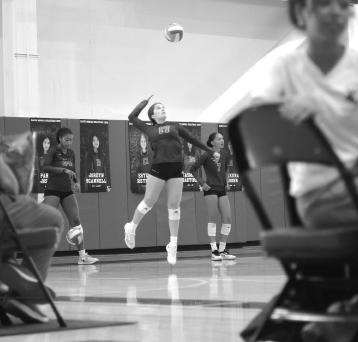

Entering a new season, the Samo boys’ football team is hard at work and looking to come back stronger from last year. After practicing all summer, the team is coming into this season ready to put up a good fight for their spot in the playoffs.
Last year, Samo boys’ football went 1-4
in league, not qualifying for the playoffs. Going into this season, the Vikings have a redemption year ahead of them and big goals. Football captain and wide receiver Payton Seals (’26) shares his mindset and thoughts going into this season.
“I’d say our whole defense is looking very good right now […] our offense is good as well,” Seals said. “I just learn that we need to get more people on board with our goal of trying to win and be great.”
Along with Seals, head coach Carter Paysinger has high hopes for the team this year. Having lost a few of their key players to injuries during last season, Paysinger is focused on keeping his athletes healthy moving forward with their season. When
asked about his focuses and learning opportunities for this season, Paysinger shared his hopes for the team.
“We spend a lot of time on life skills, time management, discipline, responsibility, teamwork and if we’re good in those areas, then we feel like we’ll be good on the field,” Paysinger said.
“Our expectations are the same as every year. For us to be competitive and have a chance to win our league championship and compete for [the] California Interscholastic Federation (CIF) championship.”
The Vikings have already played six games, with a record of 4-2, beating last year’s league champions, North Torrance, 21-13. Hopes are high as they have had
Samo girls’ tennis is back with high expectations for their 2025 season.
Last year, the Samo girls’ tennis team dominated, winning the Ocean League. The team also made it to the California Interscholastic Federation (CIF) Finals, but lost to Santa Barbara High School. They ended with an overall record of 15-4 and a league record of 7-1. It was their best season in 50 years. Now, the team is hoping to repeat last year’s success and make it to CIF’s again. They also have the added pressure of living up to last year’s season, which was one of the best Samo girls’ tennis had ever seen. Varsity captain, Stella Callen (’26) remembers last year’s
team and its growth.
“Last season, we had a really strong doubles pair and some really strong singles players who really did well in securing a lot of points for us,” Callen said. “Our communication and morale as a team really improved.”
The team performed incredibly well last season and is now even more inspired for the season ahead. They are planning to focus on having good energy and team camaraderie. Head Coach, Shaun Simone, stated the team’s goals for the upcoming season.
“Last season we made it to the division three finals championship and our goal is to get to that exact same location this year and win it,” Simone said.
A big change this year is the teams’ sin-
smashing wins against both Kaimuki High School in Hawaii with a final score of 35-0 and against Burroughs High School with a score of 35-9.
The Vikings next home game will take place at home on Oct. 10, 2025 against South Torrance High School.

thesamohinews@gmail.com
gles lineup since many of their players graduated last year. They have filled out their starting lineup with underclassmen, preparing the team for future success. In terms of improving this

year, one of the varsity team captains Rebeca Scholze (’26), shared some of their goals.
“Have a really good energy between teammates, a really together team,” Scholze said. “We think that encouraging each other and having that team camaraderie really does help mentally and tennis is a really mental game.”
The Samo girls’ tennis team is ready with a new lineup of girls to defend their title. They are excited for the chance to prove themselves again and make it back to CIF Finals and they look fierce so far. Although league matches haven’t started yet, they currently have a record of 5-1, having recently defeated Buckley High School 12-6 on Sept. 10. Their next home game is on Oct. 1, 2025.
This school year, the Samo boys’ water polo team is entering a new season with new players, new talents and new goals. The team has high hopes, with upperclassmen returning with sharpened skills and fresh talents from underclassmen joining the team.
The Samo boys’ water polo team ended their 2024-25 season with an overall record of 1916. The team finished 4th in the Bay League with a 2-5 league record. They ended the regular season on Oct. 23, 2024 with a 23-10 win against Malibu High School. In the CIF playoffs, Samo made it to the semi-finals where they lost 6-7 against Los Osos High School. Overall, the Vikings had a successful season with several players making the All-Bay League and All CIF teams.

This season, the team is dependent on strengthening the talents of returning upperclassmen and new underclassmen after losing
9 seniors last season. It is now head coach Matthew Flanders’ 29th season coaching boys’ water polo at Samo and he is hoping to rebuild the team this year.
“Game by game, we have to improve, and it’s like a crescendo towards CIF championships,” Flanders said. “You want to get better everyday. We lost a good amount of seniors, and we need to fill those holes quickly. I would be on the lookout for Luc Garland-Di Stefano (’26) and Zephyr Fehmers (’26).”
In their first home game of the season, Samo won with a score of 13-6 against Notre Dame High School. Since then, the team has won seven more games and lost
three, bringing their overall record to 8-3. On Sept. 2, 2025, in their highest-scoring game so far this season, Samo had a 24-5 win against Granada Hills Charter High School. Samo was consistently scoring every possession and each defender was staying on their player. Having won, members of the Samo team were feeling very accomplished. Team captain Garland-Di Stefano believed that the team excelled at having awareness throughout the game.
“There was a lot of good [awareness], not so much in the first quarter but as the game progressed, there were a lot of good steals and a lot of good blocks. It was just all around good awareness,” Garland-Di Stefano said.
On Oct. 7, 2025 the boys’ water polo team will be playing their next home game against Redondo Union High School.
thesamohinews@gmail.com
Ashley Ballantine Staff Writer
Starting off this year’s cross country season
Samo has shown great attitudes for the meets ahead. With impressive mile times and personal bests, the Vikings are looking good for a successful year.
Last season, Samo finished as the champi-
ons of Ocean League, qualifying for the CIF Southern Section Finals. Following that, three athletes advanced into the top ten for their three mile race times, making their mark in Samo’s history.
This season our boys’ and girls’ varsity teams have competed in three meets. A notable one being the Dana Hills Invitational Meet. What should have been a standard three mile race turned into an inconvenient 2.1 mile race when the lead cyclist guiding the boys’ varsity race took a wrong turn, cutting the course down by 0.9 miles.
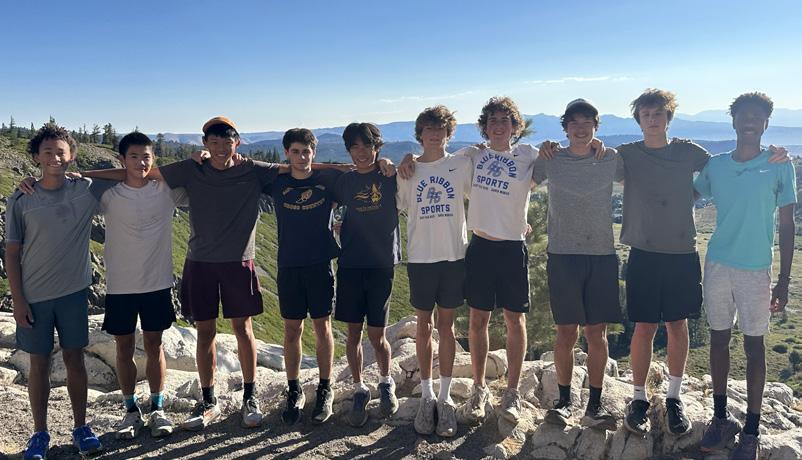
The few meets so far have been competitive with runners maintaining good pace and even better composure. During these races Samo has had multiple runners stay close together and finish with strong times.
The boys’ varsity team has been completing these races with high efforts that highlight their top performers and consis-
tent runners. The girls’ varsity has also shown great results across the board. These performances demonstrate the teams’ readiness and high level athleticism.
Katherine Saunders, the assistant coach, believes that the team is making steady progress towards their end goal of making it to state.
“Their confidence in themselves and their confidence in each other gets a little bit stronger every single week,” Saunders said. “And if we continue on that trajectory, there’s no reason why we would not make it [to state].”
As long as the cross country team can stay healthy, injury free and in the right head space, they have every chance to reach that milestone. Looking into the distance, the cross country stars have eight meets ahead of them. Hopefully continuing on to the Ocean League Finals on Nov. 5, 2025 at Columbia Park, CA. Good luck to the cross country boys’ and girls’ teams striving to reign victorious once again
